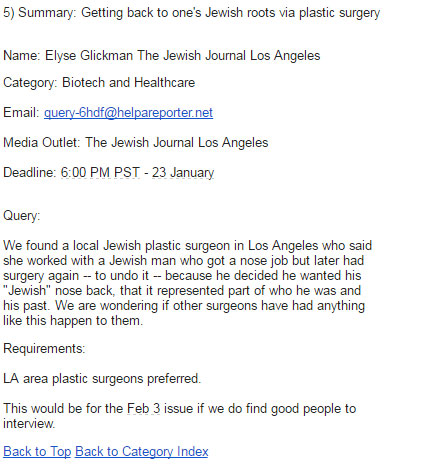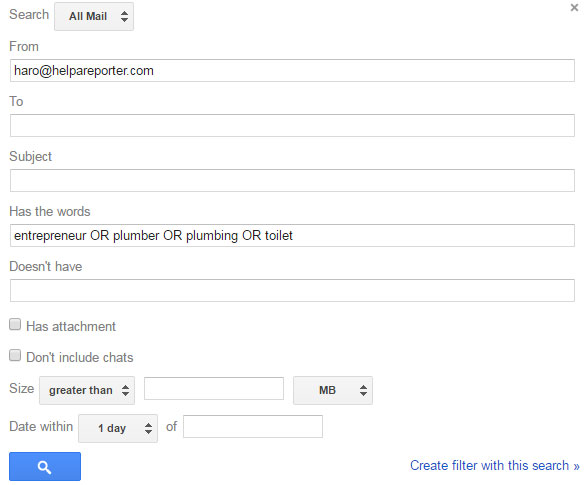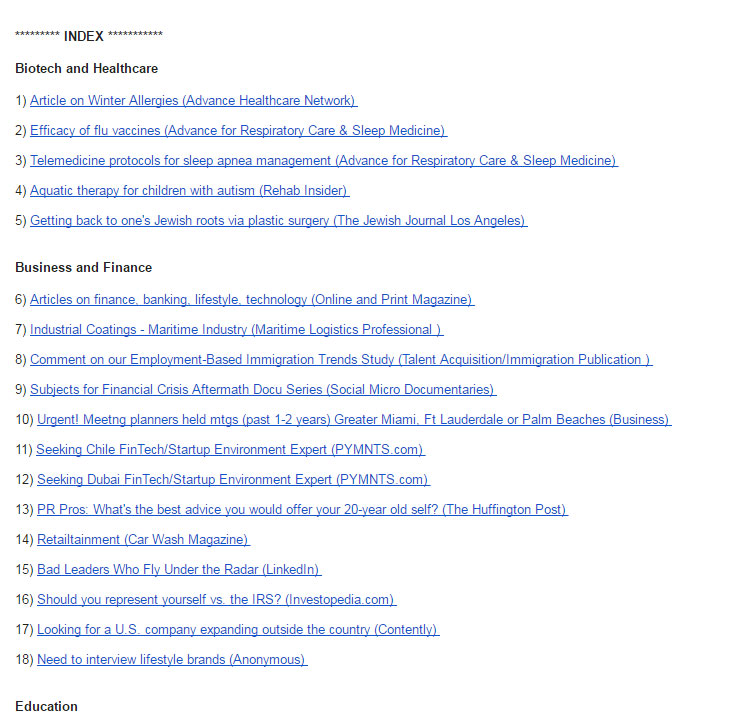Building legit links to your website is not a lot of fun. There are a ton of ways to do it and a ton of tools that can help, but most of them come with some pretty big drawbacks. It’s easy to spend days building resources and reaching out to bloggers just to come away empty handed.
Fortunately, there’s one trick I use to build strong, legit links for free. There’s very little time commitment, very little risk, and just about anyone can do it.
What is HARO?
HARO, or Help a Reporter Out, is a platform that lets reporters and bloggers get in touch with sources for quotes, sound bites, and short interviews. Sign up for free and you’ll get three emails per day with 30-100 prompts each, covering an alarmingly wide array of topics. I’m talking about stuff ranging from “Why are so many people still using Windows 7?” to “How Divorcees Spent Their First Valentine’s Day,” and the truly bizarre:

While most of these prompts will be completely irrelevant to your business, it’s worth finding the good ones. Here’s how I build links using HARO:
Step 1: Sign up for HARO
This step takes five minutes, tops. Take the time to read their rules (it’s a very short list that’s worth reading) and then sign up as a source. There isn’t much benefit to any of their paid packages unless you’re really desperate.
Step 2: Filter your HARO emails
If you use Gmail, I strongly suggest setting up a filter for your HARO emails:
![]()
With that filter in place, you can apply a color to the label to help them stand out. Whether or not that’s useful depends on how you use your inbox.
You can also set up another filter to mark some HARO emails as important (or star them, or apply another label) if they include certain keywords:

While I haven’t tried it yet, you might also want to check out this guide on using machine learning to set up personal alerts for highly-relevant HARO queries.
Step 3: Read your HARO emails
This is the hard part. Find the time to go through all three emails, Monday through Friday. Ideally you should go through them as soon as they come in, since that increases your chances of being the first reply to a prompt, but do what you can.
If nothing looks too interesting, it only takes me a couple of minutes to skim the headlines. Here’s what the format looks like:

Again, there are generally about 50 subjects per email, but there can be as few as 30 or as many as 100. They’re also arranged loosely by subject, so you can always skip over subjects that will never apply to your business.
Step 4: Pick a prompt that you can answer
I want to share just one secret with you here:
Whatever you do, don’t wait for the perfect prompt.
If you’re a plumber, you might have to wait a couple of months until you see a prompt just for plumbers. But if you’re a plumber, you’re not just a plumber. You might also be a small business owner, a Toyota owner, someone who’s dealt with a bad coworker, a former Scientologist, a dog owner, a skydiver, or someone who can recommend a great brewery in New England. No matter who you are, chances are good that you have more experience, and more insight, than you realize.
You might not want all of those responses to link back to your plumbing website, but some of them are perfectly fine. In other cases, you might be able to do a favor for another business owner (like your favorite skydiving school) and earn some points with them. There is absolutely nothing wrong with that.
Step 5: Check out the publisher’s site
What does it take to submit a prompt on HARO? Not much, it turns out. All you need to do is sign up, agree to their terms, and submit your question. To qualify, all they ask is that your publication is among the 1,000,000 most trafficked websites on earth (according to its Alexa score.)
You’re not going to want links from all of those sites.
While the best way to check up on a site’s quality is with a paid backlink checker like Ahrefs, I promised you this method would be free.
At the very least, go to the publisher’s site and see what it looks like. If it looks like it was built 10 years ago, you might want to skip it. If they would put your link alongside links to gambling and pharmaceutical sites, you definitely want to skip it.
Honestly, I’ve probably passed on fewer than five prompts because of the publisher’s site. Unless you’re building hundreds of terrible links all day long, a link from a bad site probably won’t hurt. At worst, it will do nothing at all.
Step 6: Reply
So you finally found a prompt worth replying to. Now for the fun part.
For the subject like, I use the prompt’s original subject line and just add “RE:” at the beginning, like “RE: Looking for Plumbers who Also Own Lion Fish.” That makes your intentions crystal clear.
Next, jump straight to a usable quote. Don’t introduce yourself, and don’t reply with a bunch of unnecessary context. Give the blogger something they can use. Ideally your response should be unique, clear, bold, free of grammatical mistakes, and free of spelling mistakes. If writing isn’t your strong suit, try using the Hemmingway Editor.
A lot of prompts will ask for your name, role at your company, and a link to your company’s website. Put those at the end. If you need to include a profile photo, upload one to your website at a url you can remember, or just bookmark it. I keep mine at http://www.navolutions.com/joeadamg.jpg.
At the end, hit “send” before you can overthink it.
Step 7: Wait
Some publishers will tell you when your response goes live or gets rejected. Many others won’t. Signing up for Brandmentions will let you know if a post goes live and nobody tells you about it.
In some cases, the publisher will message you back and encourage you to post it to social media and share it with everyone you’ve ever met. Whether or not you do is completely your decision.
Step 8: Do it Again
Unless you score a link from the Huffington Post’s home page, one link probably won’t be enough to put your business on the map. Rinse, repeat, and keep going until you don’t need any more good links. Of course, you’ll also need to have some decent on-site SEO if you want those links to do any good, but that’s a blog post for another day.
FAQs About Building Links with HARO
Why are some publishers listed as “Anonymous”?
Many times, publishers listed as “anonymous” are some of the biggest sites on the platform. They list themselves as anonymous because that helps prevent them from getting swamped with low quality responses.
On the other hand, any publisher can list themselves as “anonymous,” so take it with a grain of salt.
What if the prompt is for a book or an interview?
There may or may not be any SEO value there, so you can take those opportunities at face value. If you want to be interviewed on a small business podcast, go for it. If not, don’t.
Are HARO links “white hat”?
HARO links are overwhelmingly safe and “white hat.” The only time you have to worry is if the publisher doesn’t show any discretion. If they link out to casino or pharmaceutical sites, or don’t mind quoting a plastic surgeon in Phoenix about the price of tea in China, then that could be a red flag.
Can I have a friend, family member, or employee reply for me?
Whatever you do, don’t lie about who’s sending the reply. That’s bad form, and if the publisher refuses to take down something embarrassing, that’s your own fault.
If your time is limited and your friend/employee/family member has more bandwidth, your best approach is to have them read through the HARO prompts and send you the best ones. The response has to come from the email address that signed up, but there’s nothing wrong with prefacing that response with “This response comes from John Doe, owner and operator of Such and Such, Inc.:”
How many links have you successfully built?
Honestly, I stopped keeping track. If I had to guess, I’ve probably gotten 50+ links. I’m a big fan of this one, this one and this one.
Any more tips?
Here are 10 great HARO outreach tips you should check out. While it’s a little different from the approach I use, I don’t think there’s anything wrong with Wes’ approach either.





